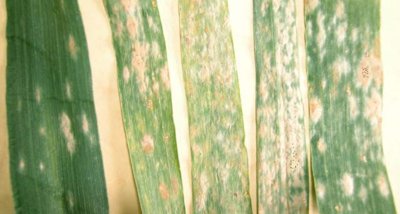Diseases
Blumeria graminis (DC) Speer f. sp. secalis Marchal (Erysiphe graminis DC) - Powdery Mildew of Rye
Systematic position.
Class Ascomycetes, subclass Euascomycetes, order Erysiphales, family Erysiphaceae, genus Blumeria.Biological group.
Biotroph.Biology and morphology.
Powdery Mildew infects many cereal species. The specialized rye form caused by the fungus B. graminis f. sp. secalis is adapted to Secale species. The fungus develops usually on the upper surface of leaves, and under favorable conditions it may attack all above-ground parts of the plant. Surface mycelium producing conidia gives the leaves a powdery appearance. These conidia are a source for other plant.s infections. Conidia develop on terminal generative cells of short and simple conidiophores. Conidia are hyaline, unicellular, ellipsoidal to ovate (8-10 x 25-30 microns). They are produced basipetally and diurnally in long chains. The conidial stage is named Oidium monilioides (Nees) Link. Germ tubes penetrate leaves, establish haustoria in epidermal cells, and give rise to surface sporulating colonies. Haustoria (5-10 x 10-30 microns) bear distinct fingerlike appendages up to 20 microns long at each apex. Later the surface mycelium condenses and forms small pads of dirty-gray, brown, rust-brown color, on which cleistothecia are formed, being dark, 135-280 microns in diameter. Each cleistothecium's asci contain 6-30 ascus. Mature asci are cylindrical to ovate (25-40 x 70-110 microns). There are 8 hyaline ascospores (10-13 x 20-23 microns) in each ascus. The fungus is heterothallic, and two mating types occur in about an equal ratio in natural populations. Initial infection of winter rye may already be carried out in autumn by ascospores or conidia from non-harvested or wild-growing plants. The fungus over-winters as mycelium on infected leaves or in cleistothecia, from where it infects plants in the spring. Conidia and ascospores may be carried a great distance by wind.Distribution:
Disease is distributed throughout all continents, where the host-plant is present. In Russia it occurs in all regions of rye cultivation.Ecology:
The best condition for disease development is damp cool weather. Optimum temperature for the Powdery Mildew is 15-18.C. In these conditions the disease incubation period lasts 3 to 7 days. Hot and dry weather stops disease development. Conidia are able to germinate in a wide range of temperatures (1-30.C), without presence of water drops, at a relative humidity near 100%.Economic significance:
Disease causes reduction of spikelets and grain number in head, and weight of the grain. At high disease development (to 60%), under artificial inoculation, the yield losses may reach 30-50%. In natural conditions the average long-term loss is estimated as 5%. Control measures include: resistant varieties, crop rotation, deep plowing, treatment of seeds and plants by fungicides.Reference citations:
Aleksandrov I.N. 1981. Powdery mildew of rye. Protection of plants against pests and diseases. Elgava: Lit. agr. acad. 65-68 p. (In Russian)Hawksworth D.L., Kirk P.M., Sutton B.C., Pegler D.N. 1995. Dictionary of the fungi. CAB International. 616 p.
Ishkova Т.I., Berestetskaja L.I., Gasich E.L. Levitin M.M., Vlasov D.Yu. 2002. Diagnostics of the main fungal diseases of cereal crops. St. Petersburg: VIZR. 76 p. (In Russian)
Levitin M.M., Tuterev S.L. 2003. Fungal diseases of cereal crops. Zashchita rastenii i karantin, 11: 75. (In Russian)
Novozhilov K.V., Zakharenko V.A., eds. 2000. Levels and tendencies of variability of species composition and intra-population structure, areas of complexes of harmful and useful organisms and forecast of dangerous phytosanitary situations in zones of the country. St. Petersburg: VIZR. 100 p. (In Russian)
Shestiperova Z.I., Polozova N.L. 1973. Powdery mildew and spots of summer grain crops. Leningrad: Kolos. 55 p. (In Russian)
Solodukhina O.V. 1990. Harmfulness of powdery mildew on diploid and tetraploid short stem rye. Bull. of appl. bot., genet. and plant breeding. St. Petersburg: VIR. V. 132: 65-70. (In Russian)


